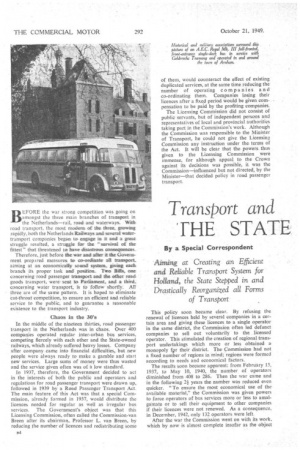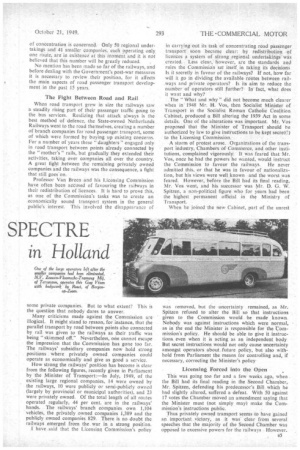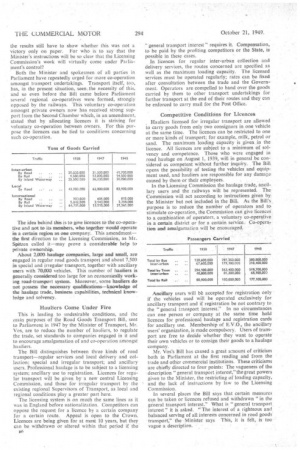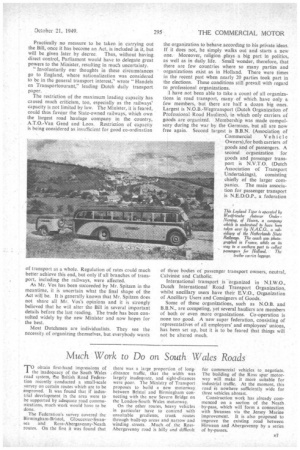Transport and THE STATE SPECTRE in Holland
Page 38

Page 39

Page 40

Page 41

If you've noticed an error in this article please click here to report it so we can fix it.
By a Special Correspondent
Aiming at Creating an Efficient and Reliable Transport System for Holland, the State Stepped in and Drastically Reorganized all Forms of Transport
BEFORE the war strong competition was going on amongst the three main branches of transport in the Netherlands—rail, road and waterways, With, road transport, the most modem: a the three_ growing rapidly, both the Netherlands Railways, andi sevorall waitertransport companies began to engagein it and a great struggle resulted, a struggle. fin the ".541iNimat of the fittest" that threatened to havedisastrous. consequences.
Therefore, just before the war and a-Xterit the Government prepared measures, to, co-ordinate all transport. aiming at an economicallysound system. giving each. branch its proper task and position.. Two BilIra., one concerning-road passenger transport and the other road goods transport, weresent to, Parliament, and a third, concerning water transport, is to follerw shortly. All' three are of the same pattern. It is hoped to eliminate Cut-throat competition, to ensure an efficient and reliable service to the public, and to guarantee a reasonable existence to the transport industry.
Chaos in the 30's In the middle of the nineteen thirties, road passenger transport in the Netherlands was in chaos. Over 400 companies operated regular inter-urban bus services, competing fiercely with each other and the State-owned railways, which already suffered heavy losses. Company after company came into financial difficulties, but new people were always ready to make a gamble and start new services. Large sums of money were thus wasted and the service given often was of a low standard.
In 1937, therefore, the Government decided to act in the interests of both the public and operators and regulations for road passenger transport were drawn up, followed in 1939 by a Read Passenger Transport Act. The main feature of this Act was that a special Commission, already formed in 1937, would distribute the licences needed for regular as well as irregular bus services. The Government'sobject was that this Licensing Commission, often called the Commission-van Breen after its chairman, Professor L. van Breen, by reducing the number of licences and redistributing some of them, would counteract the effect of existing duplicated services, at the same time reducing the number of operating companies a n d co-ordinating them. Companies losing their licences after a fixed period would be given compensation to be paid by the profiting companies.
The Licensing Commission did not consist of public servants, but of independent persons and representatives of local and provincial authorities taking part in the Commission's work. Although the Commission was responsible to the Minister of Transport, he could not give the Licensing Commission any instruction under the terms of the Act. It will be clear that the powers thus given to the Licensing Commission were immense, for although appeal to the Crown against its decisions was possible, it was the Commission—influenced but not directed, by the Minister—that decided policy in road passenger transport.
This policy soon became clear. By refusing the renewal of licences held by several companies in a certain area and giving these licences to a single operator in the same district, the Commission often led defunct companies to sell out voluntarily to the licensed operator. This stimulated the creation of regional transport undertakings which more or less obtained a monopoly fpr their district. The Commission had not a fixed number of regions in mind; regions were formed according to needs and economical factors..
The results soon became apparent: from February 15, 1937, to May 10, 1940, the number of operators diminished from 408 to 286,. Then the war came and in the following 2 years the number was reduced even quicker. "To ensure the most economical use of the available material," the Commission was given powers to force operators of bus services more or less to amalgainate or to sell their equipment to other companies if their licences were not renewed. As a consequence, in December, 1942, only 132 operators were left
After the war the Commission went on with its work, which by now is almost complete insofar as the object of concentration is concerned. Only 50 regional undertakings and 41 smaller companies. each Operating only one route, are in existence at this moment and it is not believed that this number will be greatly reduced. .
No mention has been made so far of the railways, and before dealing with the Government's post-war measures it is necessary to review their position, for it affects the main aspects of road passenger transport development in the past 15 years.
The Fight Between Road and Rail
When road transport grew in size the railways saw a steadily rising part of their passenger traffic going to the bus services. Realizing that attack always is the best method of defence, the State-owned Netherlands Railways went to the road themselves, creating a number of branch companies for road passenger transport, some of which were formed by buying up existing concerns. For a number of years these daughters " engaged only in road transport between points already connected by the " mother's" rails, but gradually they extended their activities, taking over companies all over the country. A great tight between the remaining privately owned companies and the railways was the consequence, a fight that still goes' on.
Professor Van Breen and his Licensing Commission have often been accused of favouring the railways in their redistribution of licences. It is hard to prove this, as one of the Commission's tasks was to create an economically sound transport system in the general public's interest. This involved the disappearance of some private companies. But to what extent? This is the question that nobody dares to answer.
Many criticisms made against the Commission are illogical. It might stand to reason, for instance, that the parallel transport by road between points also connected by rail was given to the railways as their traffic was being "skimmed off." Nevertheless, otie cannot escape the impression that the Commission has gone too far. The railways' subsidiary companies now hold strong positions where privately owned companies could operate as economically and give as good a service.
How strong the railways' position has become is clear from the following figures, recently given in Parliament by the Minister of Transport:—In July, 1949, of the existing large regional companies, 14 were owned by the railways, 10 were publicly or semi-publicly owned (largely by provincial or municipal authorities), and 23 were privately owned. Of the total length of all routes operated regularly, 44 per cent, are in the railways' hands. The railways' branch companies own 1,104 vehicles, the privately owned companies 1,389 and the publicly owned companies 829. There is no doubt the railways emerged from the war in a strong position.
I have said that the Licensing Commission's policy in carrying can its task of concentrating road passenger transport soon became clear: by redistribution of licenees a system of strong regional undertakings was created.. Less clear, however, are the standards and rules the Commission set itself, in taking its decisions Is it secretly in favour of the railways? If not, how far will it go in dividing the available routes between railways and private operators? • Is its aim to reduce the number of operators still further? In' fact, what does it want and why?
The "What and why" did not become much clearer when in 1948 Mr. H. Vos, then Socialist Minister of Transport in the Socialist Roman Catholic Coalition Cabinet, produced a Bill altering the1939 Act in some details. One of the alterations was important. Mr. Vos proposed that the Minister of Transport should he authorized by law to give instructions to be kept secret(!)
to the Licensing Commission. .
A storm of protest arose. Organizations of the transport industry, Chambers of Commerce, and other institutions, complained vigorously. It was feared that Mr. Vos, once he had the powers he wanted, would instruct the Commission to favour the railways. He never admitted this, or that he was in favour of nationalization, but his views were well known and the worst was feared. However, before the Bill had its final reading, Mr. Vos went, and his successor was Mr. D. G. Spitzen, a non-political figure who for years had been the highest permanent official in the Ministry of Transport.
When he joined the new Cabinet, part of the unrest was removed, but the uncertainty remained, as Mr. Spitzen refused to alter the Bill so that instructions given to the Commission would be made known. Nobody was against instructions which were normal, as in the end the Minister is responsible for the tornmission's policy. He should be able to give it instructions even when it is acting as an independent body But secret instructions would not only cause uncertainty amongst operators about future policy, but also withhold from Parliament the means for controlling and, if necessary, correcting the Minister's policy Licensing Forced into the Open This was going too far and a few weeks ago, when the Bill had its final reading in the Second Chamber, Mr. Spitzen, defending his predecessor's Bill which he had slightly altered, suffered a defeat. With 50 against 17 votes the Chamber moved an amendment saying that the Minister must (not simply may) make the Commission's instructions public.
Thus privately owned transport seems to have gained an important victory, as it was clear from several speeches that the majority of the Second Chamber was opposed to excessive powers for the railways However. the results still have to show whether this was not a victory only on paper. For who is to say that the Minister's instructions will be so clear that the Licensing Commission's work will virtually come under Parliament's control?
Both the Minister and spokesmen of all parties in Parliament have repeatedly urged for more co-operation amongst transport undertakings. Transport itself, too, has, in the present situation, seen; the necessity of this, and so even before the Bill came before Parliament several regional co-operatives were formed, strongly opposed by the railways. This voluntary co-operation amongst private owners now has received strong support from the Second Chamber which, in an amendment, stated that by allocating licences it is striving for voluntary co-operation between owners. For this purpose the licences can be tied to conditions concerning such co-operation.
The idea behind this is to give licences to the co-operative and not to its members, who together vvouhl operate in a certain region as oec company. This amendment— the first direction to the Licensing Commission, as Mr_ Spitzen called it—may prove a considerable help try private ownership.
About 2,000 haulage companies, large and small, are engaged in regular road goods transport and about 7,500 in special and irregular transport, together with ancillary users with 70,000 vehicles. This number of hauliers is generally considered too large for an economically working road-transport system_ Moreover, some hauliers do not possess the necessary qualifications—knowledge of the haulage trade, business capabilities, technical knowledge and solvency.
Hauliers. Come Under Fire
This is leading to undesirable conditions, and the main purposes of the Road Goods Transport Bill, sent to Parliament in 1947 by the Minister of Transport, Mr. Vos, are to reduce the number of hauliers, to regulate the trade, set standards to companies engaged in it and to encourage amalgamation of and co-operation amongst hauliers.
The Bill distinguishes between three kinds of road transport—regular services and local delivery and collection; special and irregular transport; and ancillary users. Professional haulage is to be subject to a licensing system; ancillary use to registration. Licences for regular transport will be given by a new central Licensing Commission, and those for irregular transport by the existing regional Supervisors of Transport, as local and regional conditions play a greater part here.
• The licensing system is on much the same lines as it was in England before nationalization. Competitors can oppose the request for a licence by a certain company for a certain route. Appeal is open to the Crown. Licences are being given for at most 10 years, but they can be withdrawn or altered within that period if the
"general transport interest" requires it. Compensation, to be paid by the profiting competitors or the State, is possible in these cases.
In licences for regular inter-urban collection and delivery services, the routes concerned are specified as well as the maximum loading capacity. The licensed services must be operated regularly; rates can be fixed after consultation between the trade and the Government. Operators are compelled to hand over the goods carried by them to other transport undertakings for further transport at the end of their routes and they can be enforced to carry mail for the Post Office.
Competitive Conditions for Licences
Hauliers licensed for irregular transport are allowed to carry goods from only two consignors in one vehicle at the same time. The licences can be restricted to one or more kinds of transport; for example, milk, petrol or sand. The maximum loading capacity is given in the licence. All licences are subject to a minimum of solvency and competence. Those who were engaged in road haulage on August 1, 1939, will in general be considered as competent without further inquiry. The Bill opens the possibility of testing the vehicles and equipment used, and hauliers are responsible for any damage caused by them or their employees.
In the Licensing Commission the haulage trade, ancillary users and the railways will be represented. The Commission will act according to instructions given by the Minister but not included in the Bill. As the Bill's purpose is to reduce the number of operators and to stimulate co-operation, the Commission can give licences to a combination of operators, a voluntary co-operative in a certain district or for a certain service. Co-opera? tion and amalgamation will be encouraged.
Ancillary users will bE accepted for registration Only if the vehicles used will he operated exclusively for ancillary transport and if registration be not contrary to the "general transport interest." In no circumstances can one person or company at the same time hold licences for professional haulage and registration cards for ancillary use. Membership of E.V.O., the ancillary users' organization, is made compulsory. Users of transport are free to decide "whether they want to operate their own vehicles or to consign their goods to a haulage company.
Mr. Vos's Bill has caused a great amount of criticism both in Parliament at the first reading and from the trade and other commercial institutions. These criticisms are chiefly directed to four points: The vagueness of the description "general transport interest,"the great powers given to the Minister, the restricting of loading capacity, and the lack of instructions by law to the Licensing Commission.
In several places the Bill says that certain measures can be taken or licences refused and withdrawn "in the general transport interest." What is "general transport interest" it is asked. "The interest of a righteous and balanced serving of all interests concerned in road goods transport," the Minister says This, it is felt, is too vague a description. Practically no measure to be taken in carrying out the Bill, once it has become an Act, is included in it, but will be given later by decree, Thus, without having direct control, Parliament would have to delegate great powers to the Minister, resulting in much uncertainty.
"Involuntarily our thoughts in these circumstances go to England, where nationalization was considered to be in the general transport interest," wrote " Handels en Transportcourant," leading Dutch daily transport paper.
The restriction of the maximum loading capacity has caused much criticism, too, especially as the railways' capacity is not limited by law. The Minister, it is feared, could thus favour the State-owned railways, which own the largest road haulage company in the country, A.T.O.-Van Gend and Loos. Restriction of capacity is being considered as insufficient for good co-ordination of transport as a whole. Regulation of rates could much better achieve this end, but only if all branches of transport, including the railways, were affected.
As Mr. Vos has been succeeded by Mr. Spitzen in the meantime, it is uncertain what the final shape of the Act will be. It is generally known that Mr. Spitzen does not share all Mr. Vos's opinions and it is strongly believed that he will alter the Bill in several important details before the last reading. The trade has been consulted widely by the new Minister and now hopes for the best.
Most Dutchmen are individualists. They see the necessity of organizing themselves, but everybody wants.
the organization to behave according to his private ideas. If it does not, he simply walks out and starts a new one. Moreover, religion plays a big part in politics, as well as in daily life. Srnall wonder, therefore, that there are few countries where so many parties and organizations exist as in Holland. There were times in the recent past when nearly 20 parties took part in the elections. These conditions still prevail with regard to professional organizations.
1 have not been able to take a count of all organizations in road transport, many of which have only a few members, but there are half a dozen big ones. Largest is NO.B.-Wegtransport (Dutch Organization of Professional Road Hauliets), in which only carriers of goods are organized. Membership was made compulsory during the war by the Germans, but all are now free again. Second largest is B.B.N. (Association of Commercial Vehicle Owners),for both carriers of goods and of passengers. A second organization for goods and passenger transport is N.V.T.O. (Dutch Association of Transport Undertakings), consisting chiefly of the larger cornpanies. The main association for passenger transport is N.E.D.O.P., a federation
of three bodies of passenger transport owners, neutral, Calvinist and Catholic.
International transport is organized in N.I.W.O., Dutch International Road Transport Organization, whilst ancillary users have their E.V.O., Organization of Ancillary Users and Consigners of Goods.
Some of these organizations, such as N.O.B. and B.B.N., are competing, yet s-everal hauliers are members of both or even more organizations. Co-operation is none too good. A new super federation, consisting of representatives of all employers' and employees' unions, has been set up, but it is to be feared that things will not be altered much.




























































































